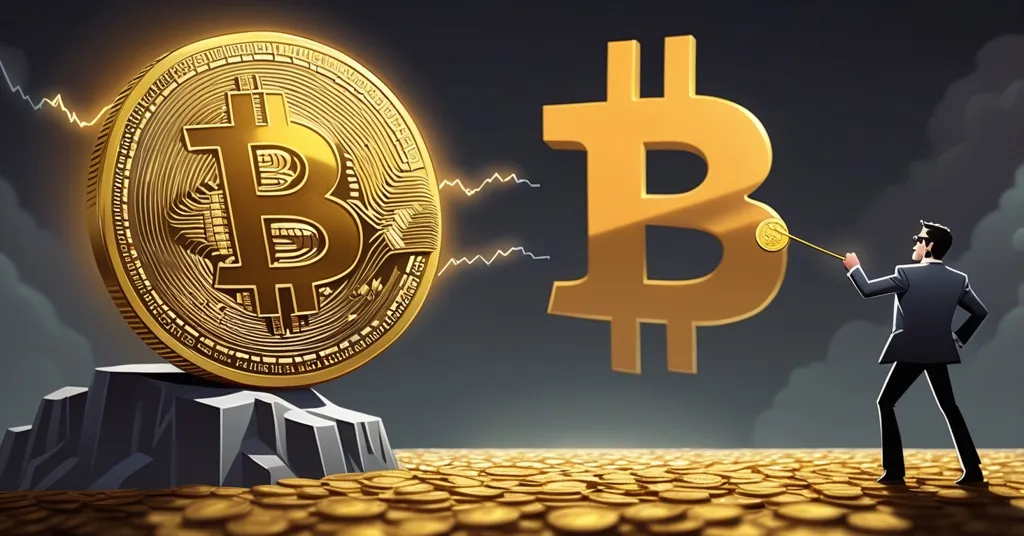Peter Schiff Slams Bitcoin, Pushes Silver as BTC Hits $117K: Hodlers Digest July 6-12

Peter Schiff Urges Bitcoin Sell-Off for Silver as $258K BTC Price Prediction Looms: Hodlers Digest, July 6-12
Bitcoin is shattering records, blasting past $112,000 to trade at $117,967, while the crypto market cap hits a staggering $3.68 trillion. Yet, amid the euphoria, Peter Schiff is sounding the alarm, urging investors to dump BTC for silver. This week’s Hodlers Digest unpacks the dizzying highs, regulatory snarls, political quagmires, celebrity NFT wins, and the persistent risks lurking beneath the bull run.
- Bitcoin surges past $112,000, now at $117,967, with a $3.68 trillion crypto market cap.
- Peter Schiff pushes a Bitcoin sell-off for silver, warning of potential crashes.
- SEC delays, political crypto ties, and Snoop Dogg’s NFT haul headline a chaotic week.
Bitcoin’s Record Rally: King of the Hill
Bitcoin is on an absolute tear, carving out new territory with a peak above $112,000 and closing the week at $117,967, per CoinMarketCap data. The total cryptocurrency market capitalization has ballooned to $3.68 trillion, fueled by unrelenting investor optimism and institutional muscle—U.S. Bitcoin ETFs alone have amassed over $50 billion since their debut. Analyst Matthew Hyland summed up the momentum, stating that BTC has confirmed a daily higher-high, snapping a downtrend that dragged since late May. Macro factors like inflation fears and a weakening dollar are likely adding tailwinds, while on-chain data shows whale accumulation and steady miner holding, signaling confidence in further gains. Even wilder, analyst apsk32, using a power law model—which assumes Bitcoin’s value grows exponentially over time like tech adoption trends—predicts a staggering $258,000 target if historical patterns hold. But let’s pump the brakes: these moonshot forecasts often lean more on hype than hard science, so don’t bet your life savings just yet.
As a Bitcoin maximalist at heart, I see this rally as a testament to BTC’s dominance and its disruptive potential as the future of money. Its censorship resistance and decentralized ethos remain unmatched, setting it apart from any centralized financial system. Yet, even I’ll admit that not every spike is a straight shot to the stars—history’s littered with bull runs turned busts, from 2017 to 2021. So, while the numbers dazzle, let’s dig into the cracks beneath the surface.
Skeptics and Hedges: Schiff’s Silver Sermon
Enter Peter Schiff, the perennial crypto naysayer and gold enthusiast, who’s crashing the Bitcoin party with a blunt message: cash out now and buy silver.
“With Bitcoin hitting new highs today (in dollars), it’s a great time to sell some and buy silver ahead of silver’s next big leg up,”
he proclaimed. His logic is sharp and simple:
“BTC can easily crash, silver’s downside seems very limited.”
Schiff argues silver offers stability with industrial demand and lower volatility, a safe harbor compared to Bitcoin’s speculative swings. It’s not a baseless pitch—silver’s tangible utility and historical role as a store of value give it a grounded appeal, especially if a black swan event tanks digital assets. Could Schiff be onto something if the market overheats? Past crashes suggest it’s not impossible, as explored in ongoing debates over Bitcoin versus silver.
Still, let’s play devil’s advocate against his stance. Bitcoin isn’t just another asset; it’s a rebellion against fiat decay, a decentralized lifeline for financial freedom. Silver can’t match BTC’s borderless, permissionless nature—try sending a silver bar across the globe in seconds. Schiff’s caution might resonate with risk-averse investors, but it underestimates the paradigm shift Bitcoin represents. Hedging has its place, sure, but ditching BTC entirely at this stage feels like abandoning a revolution mid-battle. The real question is whether you’re bracing for a storm that may never come or riding the wave of inevitable adoption. For deeper insight into Schiff’s background and criticism of Bitcoin, his track record speaks volumes.
Regulatory Roadblocks: Grayscale’s SEC Standoff
While individual investors weigh Schiff’s warnings, institutional players are slugging it out with regulators. Grayscale, a major digital asset manager, is fuming over the U.S. Securities and Exchange Commission (SEC) delaying approval of its Digital Large Cap Fund ETF—a product meant to give diversified exposure to top cryptocurrencies like Bitcoin and Ethereum. Despite initial approval from the SEC’s Division of Trading and Markets, the decision was stalled by the Office of the Secretary, prompting Grayscale’s legal team to cry foul over violated statutory deadlines. This isn’t mere paperwork; it’s a glaring sign of friction between traditional oversight and crypto’s push for mainstream legitimacy. For newcomers, ETFs (exchange-traded funds) are investment vehicles traded on stock exchanges, offering a safer, regulated way to bet on crypto without holding coins directly. Delays like this, detailed in reports on Grayscale’s SEC challenges, frustrate investors hungry for Wall Street access and slow the industry’s integration into broader finance.
But there’s a flip side—are regulators just clinging to outdated frameworks, or genuinely protecting the public from untested waters? The SEC’s caution isn’t unwarranted; crypto’s volatility and past scams (think Terra-LUNA) justify scrutiny. Yet, a sliver of optimism exists—SEC Chair Paul Atkins has floated ideas for simplifying ETF approvals through automation and transparency, hinting at a future where firms like Grayscale might face fewer hurdles. This tug-of-war shapes whether crypto remains a niche rebel or becomes a household name. For now, it’s a bitter waiting game.
Political Quagmires: Binance, Trump, and Ethical Minefields
Shifting to murkier waters, Binance, the heavyweight crypto exchange, is entangled in a controversy that could dent crypto’s ethos of neutrality. Reports reveal Binance coded a stablecoin, USD1, for World Liberty Financial (WLF), a venture linked to Donald Trump and his sons, including Eric Trump. For the uninitiated, stablecoins are cryptocurrencies pegged to assets like the U.S. dollar to minimize volatility, often used as a safe bridge in trading or payments. Here’s the kicker: a $2 billion investment from Abu Dhabi’s MGX was funneled through this stablecoin, spotlighting crypto’s intersection with political power. Worse still, Binance founder Changpeng Zhao (CZ), who pled guilty to anti-money-laundering violations in 2023, has requested a pardon from Trump. The optics are abysmal—crypto risks looking like a political pawn rather than a bastion of freedom, as highlighted in coverage of Binance’s ties to Trump.
Former White House ethics lawyer Richard Painter didn’t hold back, warning of glaring conflicts:
“We cannot have the people who are in charge of passing legislation and enforcing legislation, implementing legislation, have conflicts of interest with their official responsibilities. You should be divesting from crypto if you’re going to be regulating crypto.”
He’s got a point. As crypto grows, so does the danger of it being co-opted by vested interests, eroding trust among users who value decentralization above all. On the counter, some might argue political ties could fast-track favorable legislation, but at what cost? If crypto becomes a tool for the elite, it betrays its core promise. This drama isn’t just gossip—it’s a test of whether the industry can stay true to its roots amid high-stakes games.
Cultural Wins and Losses: Snoop Dogg’s NFT Boom and Trader Busts
Think NFTs are dead? Snoop Dogg just dropped a $12 million reality check. The rapper sold out nearly a million non-fungible tokens—unique digital assets often tied to art or collectibles, verified on blockchains—on Telegram’s TON network in just 30 minutes. Telegram founder Pavel Durov hyped the frenzy, promising blockchain minting and secondary markets will launch soon, calling it “wild.” TON, for the unfamiliar, is Telegram’s associated decentralized platform, designed for fast, user-friendly transactions. Snoop’s haul proves celebrity clout paired with accessible tech can reignite interest in a market many dismissed as a 2021 bubble. It’s a small victory for decentralized platforms empowering creators, showing cultural phenomena can drive adoption where raw tech sometimes falters.
But not everyone’s popping bottles. Crypto trader James Wynn made headlines for all the wrong reasons, deactivating his X account after catastrophic losses from high-leverage trading—a risky play where you borrow big to amplify bets, only to get wiped out if the market turns. Think of it as gambling with a loan shark; one bad call and you’re done. Public wallet data shows a pathetic $10,176 left in his accounts—a brutal reminder that for every Bitcoin moonshot, someone’s nursing a crater-sized loss. This isn’t just a sob story; it’s a damn cautionary tale against treating crypto like a casino. If it smells like a get-rich-quick scheme, it probably is—stick to fundamentals over FOMO, especially considering warnings about potential Bitcoin crashes.
Legal Lingering Pains: FTX Fallout and Beyond
The ghosts of crypto past still haunt us, with the FTX bankruptcy saga dragging on. Chinese creditor Weiwei Ji, representing over 300 individuals, is challenging the exchange’s move to pause payouts in restricted jurisdictions, arguing USD settlements are legal. This highlights a messy truth: crypto’s global nature clashes with local laws, creating headaches for how assets are distributed post-collapse. It’s not just FTX; jurisdictional tangles could set precedents for future failures, impacting how international users trust or engage with the space. Are we building a borderless future, or just new barriers in disguise?
Elsewhere, Anatoly Legkodymov, former CEO of Bitzlato—a lesser-known exchange—has requested a pardon from Trump after serving 18 months for running an unlicensed money transmitting business. And in France, an investigation into X for alleged algorithmic manipulation and foreign interference could ripple into crypto communities who lean on social platforms for hype and discourse. These legal battles, though varied, underscore a shared theme: while Bitcoin’s price climbs, trust and legitimacy remain fragile, constantly tested by regulators and bad actors alike.
Altcoins and Stablecoins: Filling the Gaps
Zooming out to the wider market, altcoins—any cryptocurrency besides Bitcoin—show a mixed bag. MemeCore spiked an absurd 1,234.52%, likely a pump-and-dump waiting to implode, while Stellar and Story gained a solid 59.52% and 49.69%. Losses hit Jito, OKB, and Pi, down as much as 4.57%. Beyond raw numbers, these swings reflect speculative mania in niches Bitcoin doesn’t touch. Ethereum, for instance, got a nod from co-founder Joseph Lubin for its scalability and legal footing in the U.S., cementing its role in smart contracts and decentralized apps. While I lean Bitcoin-first, I’ll concede a multi-chain world seems inevitable—altcoins and platforms like TON fill gaps BTC shouldn’t or can’t, from NFTs to programmable finance.
Then there’s stablecoin buzz, with LVRG Research Director Nick Ruck forecasting a $1-2 trillion market cap in coming years if a crypto-friendly SEC and legislation align. Stablecoins could be a game-changer, offering stability for transactions and DeFi (decentralized finance), but they’re not without risks—think regulatory crackdowns or peg failures like TerraUSD. It’s a bold vision, one that could anchor parts of this volatile market if executed right, though skeptics like Schiff continue to question broader crypto investment impacts.
Key Takeaways and Questions
- What’s driving Bitcoin’s surge past $112,000?
Institutional adoption, with $50 billion in U.S. Bitcoin ETFs, alongside macro fears like inflation, whale accumulation, and historical trend models, are fueling the rally, despite overblown predictions like $258K. - Should you heed Peter Schiff’s call to sell Bitcoin for silver?
Schiff’s push for silver’s stability offers a hedge against BTC’s swings, but it ignores Bitcoin’s unique decentralized value—consider diversifying, not abandoning, based on your risk tolerance, as discussed in analyses of his preference for silver. - How do SEC delays like Grayscale’s affect crypto’s mainstream push?
They stall accessible investment products, frustrating growth, though hints of regulatory reform suggest temporary hurdles—long-term, ETFs could bridge crypto to traditional finance. - Are political ties like Binance’s with Trump a threat to crypto’s ethos?
Absolutely, they risk politicizing a space built on neutrality, potentially eroding trust and inviting harsher oversight, even if some see legislative upside. - Does Snoop Dogg’s NFT success hint at a digital collectibles comeback?
It shows celebrity-driven projects on platforms like TON can spark interest, but whether it’s a lasting revival or fleeting hype depends on broader utility and adoption.
As Bitcoin skyrockets, the crypto landscape remains a battlefield of innovation versus risk. Regulatory clamps, ethical dilemmas, and speculative traps litter the path, yet the disruptive power of decentralization—from stablecoins to NFTs—keeps pushing boundaries. Schiff may play the grumpy skeptic, but even maximalists like myself know a critical eye and balanced approach never hurt, especially when considering his latest critiques on Bitcoin versus silver investments. Are you all-in on this financial revolution, or hedging your bets? The stakes couldn’t be higher, and we’ll keep dissecting every twist—good, bad, or downright ugly—in the weeks ahead.



